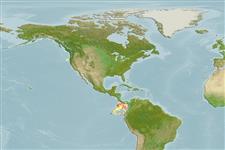Classificação / Names
Nomes comuns | Sinônimos | Catalog of Fishes(Gênero, Espécies) | ITIS | CoL | WoRMS | Cloffa
>
Ophidiiformes (Cusk eels) >
Ophidiidae (Cusk-eels) > Neobythitinae
Etymology: Porogadus: Greek, poros = porous + Latin, gadus = a fish, cod? (Ref. 45335).
More on author: Garman.
Environment: milieu / climate zone / depth range / distribution range
Ecologia
marinhas batidemersal; intervalo de profundidade 245 - 3300 m (Ref. 125143), usually 1800 - 3300 m (Ref. 125143). Deep-water; 10°N - 0° (Ref. 125143)
Eastern Pacific.
Tamanho / Peso / Idade
Maturity: Lm ? range ? - ? cm
Max length : 46.5 cm SL macho/indeterminado; (Ref. 125143)
Descrição suscinta
Morfologia | Morfometria
This species is distinguished by the following characters: precaudal vertebrae 17-19; lower first gill arch with long gill rakers 11-13; pectoral-fin rays 19-22; HL:HD 1.81-2.08; in small specimens, head spines strong, while in in large specimens short and poorly extruding, present on ethmoidal, lacrimal, prefrontal (weak), interorbital (weak), supraorbital (weak in large specimens), sphenotic, 5th infraorbital, supratemporal (absent in large specimens), inner and outer posttemporal (absent in large specimens), inner and outer preopercular rims (absent in large specimens); opercular spine is sharp, strong, extruding; maxilla with no or few scales at rear; lower lateral line pores until beginning of anal fin 22-24; vomer with a broad dentition patch
(3-9 rows of teeth); palatines with broad dentition patch (2-11 rows of teeth); otolith with separate ostial and caudal colliculi indicated by ventral incision; OL:OH = 1.75-2.1; OL:TCL = 1.8-1.9 (Ref. 125143).
Rare species (Ref. 34024). This species ventures out for about 800 km from the continental break and occurs primarily between 1800 and 3300 m but two specimens were caught in very shallow water at 245 m or near the surface. The reason for the unusual shallow catches are not known (Ref. 125143). Reproductive strategy possibly similar to other members of this family featuring oviparity, with oval pelagic eggs floating in a gelatinous mass (Ref. 205).
Ciclo de vida ou comportamento de acasalamento
Maturidade | Reprodução | Desova | Ovos | Fecundidade | Larvas
Schwarzhans, W.W. and P.R. Møller, 2021. Revision of the ‘dragon-head’ cusk eels of the genus Porogadus (Teleostei: Ophidiidae), with description of eight new species and one new genus. Zootaxa 5029(1):001-096. (Ref. 125143)
Status na Lista Vermelha da UICN (Ref. 130435)
Ameaça para os humanos
Harmless
Uso pelos humanos
Pescarias: sem interesse
Mais informação
Nomes comunsSinônimosMetabolismoPredadoresEcotoxicologiaReproduçãoMaturidadeDesovaAgregação de desovaFecundidadeOvosDesenvolvimento dos ovos
Idade/TamanhoCrescimentoPeso-comprimentoComprimento-comprimentoFrequências de comprimentoMorfometriaMorfologiaLarvasDinâmica larvalRecrutamentoAbundânciaBRUVS
ReferênciasAquaculturaPerfil para aquaculturaEstirpesGenéticaElectrophoresesHereditariedadeDoençasProcessamentoNutrientsConversão de massa
ColaboradoresFotosStamps, Coins Misc.SonsCiguateraVelocidadeTipo de nataçãoÁrea branquialOtólitosCérebrosVisão
Ferramentas
Relatórios especiais
Baixar XML
Fontes da internet
Estimates based on models
Preferred temperature (Ref.
123201): 2.6 - 3.1, mean 2.7 °C (based on 6 cells).
Índice de diversidade filogenética (Ref.
82804): PD
50 = 0.5001 [Uniqueness, from 0.5 = low to 2.0 = high].
Bayesian length-weight: a=0.00380 (0.00165 - 0.00876), b=3.14 (2.93 - 3.35), in cm total length, based on LWR estimates for this (Sub)family-body shape (Ref.
93245).
Nível Trófico (Ref.
69278): 3.7 ±0.6 se; based on size and trophs of closest relatives
Resiliência (Ref.
120179): médio(a), tempo mínimo de duplicação da população 1,4 - 4,4 anos (Preliminary K or Fecundity.).
Fishing Vulnerability (Ref.
59153): Moderate vulnerability (43 of 100).
